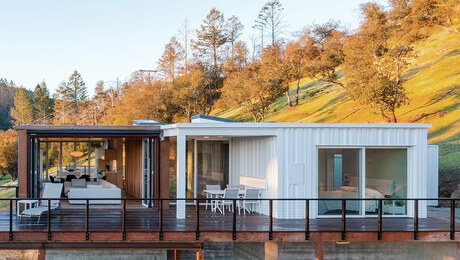All-Around Efficient
Pairing a proven net-zero strategy with conscious material choices.

Synopsis: Architect Steve Baczek writes about a net-zero home he designed that is constructed with sustainable materials. This particular house, in Hamilton, Mass., achieves such high performance through its durable envelope, tight wall assembly, high-efficiency mechanicals, and a 14.6kw photovoltaic system on its low-slope roof.
I see two paths to being green. (I don’t like that term, but lack of a better one forces me to use it.) Path 1 is designing a typical code-built house and then applying a degree of recycled materials and site-generated energy in an attempt to make up for building-performance inadequacies. Path 2, my preference, is to integrate performance strategies with scrutinized building practices to develop a house where all the decisions are in harmony with each other. While energy efficiency is always a concern, conceptually I don’t solve for it. I concentrate on durability, comfort, and health, making sure to align them with environmental responsibility, particularly in terms of material choices — and then energy efficiency comes along for the ride. The result is a comfortable, healthy home that is durable enough to last a long time, that will remain a high-performance home for decades, and that will have a minimal impact on the environment.
I recently had a great opportunity to design a home in this way with Don and Amy Bowen. If you ask them to describe their lifestyle, you’ll hear words such as simple, environmentally thoughtful, minimalist, uncluttered, and free — which is to say free from a burdened conscience, the trappings of high energy bills, and arduous home maintenance. They live this way in part to have the time and money to pursue their favorite leisure-time activities, but mostly because they are passionate about the fight against climate change.
With that philosophy in mind, Don and Amy came to me. Their goals were clear: First, the house had to generate at least as much energy as it consumed. Second, all materials had to be considered for their environmental impact, including both their recycled content and their recyclability. Local materials were to be given the highest priority, and domestically manufactured materials were to be chosen before products from abroad. Third, the house had to strive for a nearly maintenance-free exterior.
The Bowens’ passion for this house was personal. They were not interested in a plaque, so I didn’t design the house to meet LEED or Passive House or any other standard. Despite that, it is easy to see the influence that the LEED and Passive House standards had on the design. Meeting net-zero energy is a relatively easy concept to succeed at in theory: You build a house, determine the loads, and then design a PV system to balance them out. Although many find it as simple as that, my scrutiny extends a bit further. Developing a net-zero-energy home based only on the economics of energy used/purchased/generated is missing half of the equation. The home’s performance should be elevated in an effort to reduce the burden of site-generated energy.
For more photos, drawings, and details, click the View PDF button below:
Fine Homebuilding Recommended Products
Fine Homebuilding receives a commission for items purchased through links on this site, including Amazon Associates and other affiliate advertising programs.

100-ft. Tape Measure

Plate Level

Smart String Line


























